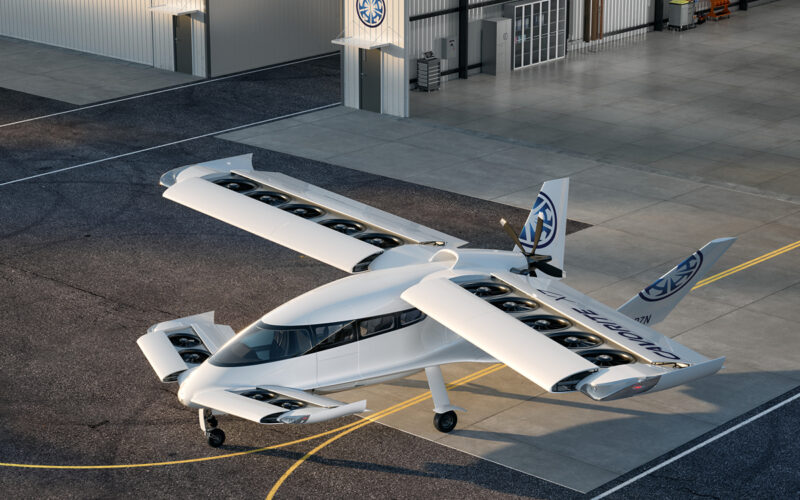Within the world of aviation, the launch of commercial eVTOL (electric Vertical Take-off/Landing) flights is starting to loom large on the radar screen. As it does, one aircraft is seeking to capture a particular slice of the advanced air mobility market, one that none of its rivals can challenge – that is, the provision of electric flights for seven people flying at up to 250 knots (450kph) and with a stage length of around 500 miles (800km). That aircraft is the Horizon Aircraft Cavorite X7.
Having met with Phil Kelly, Senior Vice President of Business Development of Canada-based Horizon Aircraft at the Farnborough Air Show in July 2024, AeroTime examines this unique aircraft, analyses the technology behind it, and looks at what might come next for this long-range hybrid eVTOL pioneer.
What is the Cavorite X7?
The Cavorite X7, named after the fictional gravity-defying material in H.G. Wells’ 1901 novel ‘The First Men in the Moon’, is a hybrid eVTOL aircraft that combines a conventional aero engine with battery-powered wing-based fans. It features a forward-swept main wing, plus a smaller set of horizontal canard-style stabilizers mounted on the forward fuselage. The aircraft also has twin-boom vertical stabilizers to the rear and a monocoque cabin that can accommodate up to six passengers, plus the operating pilot.
The key difference between the Cavorite X7 versus other eVTOL aircraft currently under development is that, while exposed rotors are the primary source of vertical thrust in those aircraft (except for the Lilium Jet), the Cavorite X7 uses electrically-driven hidden fans embedded within the swept wing structures to provide vertical lift – a system referred to by the company as its patented ‘HOVR Wing’ design.
This unique ‘fan-in-wing’ design combines the agility and versatility of a helicopter with the speed and strength of a conventional aircraft.
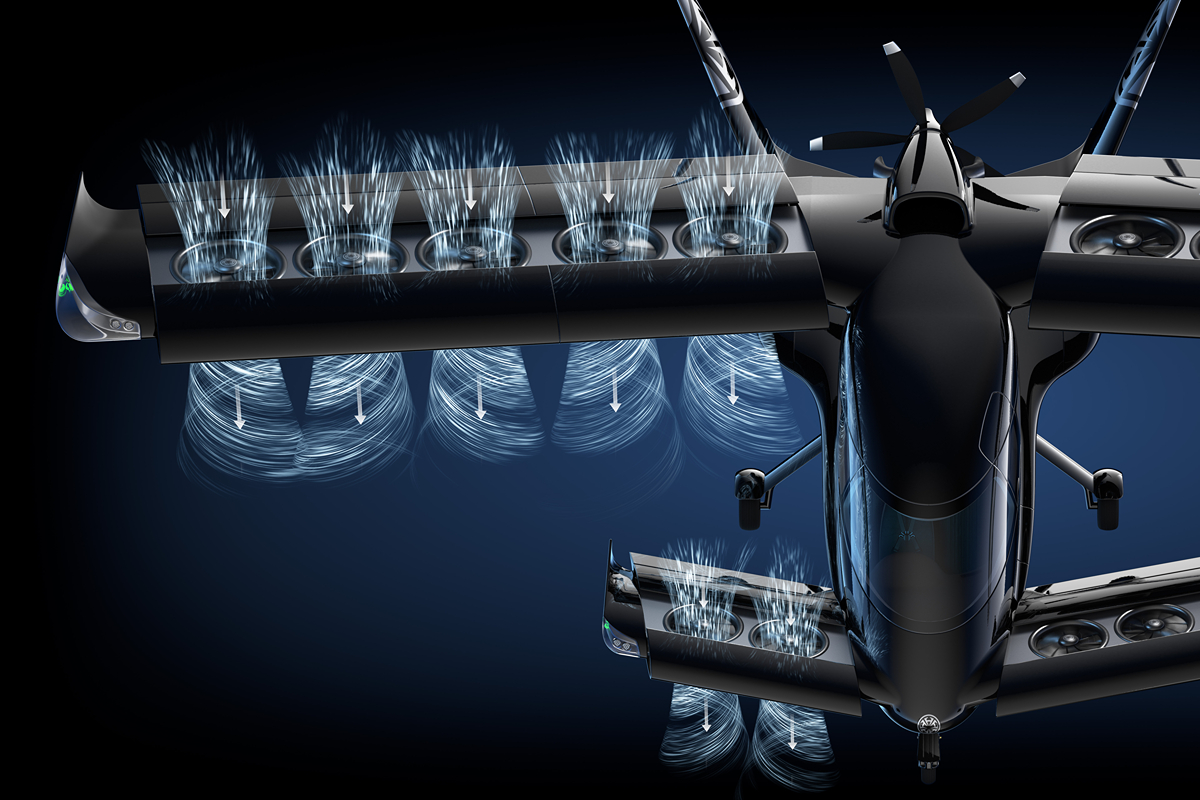
During the take-off and landing phases of flight, the wing surfaces can transform from a smooth horizontal flying surface into a stabilizer, housing 14 fans that provide the lift for vertical flight – five embedded on either side of the main wing, plus a further two mounted either side within the forward canard wings. The fans are exposed by way of slidable surfaces that retract into the wing structure when commanded by the operating pilot. This allows air to be drawn through the top of the fan and expelled out through the bottom in the form of downward thrust.
Many eVTOL aircraft rely on the same mounted rotors to provide vertical lift and then transpose into a rearward-facing position for the transition to forward flight. However, the Cavorite X7 uses a different approach.
Once airborne, the aircraft relies on a conventional rear-mounted propeller to provide forward thrust, while the panels that cover the wing-mounted fans return to their fully closed position. It is at this point that the Cavorite X7 assumes the configuration of a regular airplane, with the engine and propeller providing forward thrust and the wings providing the necessary lift.
In this forward flight configuration, the Cavorite X7 is capable of far longer-range missions than its competitors, given that it relies on the single engine for propulsion, rather than multiple rotor sets as seen on other helicopter-style eVTOL designs.
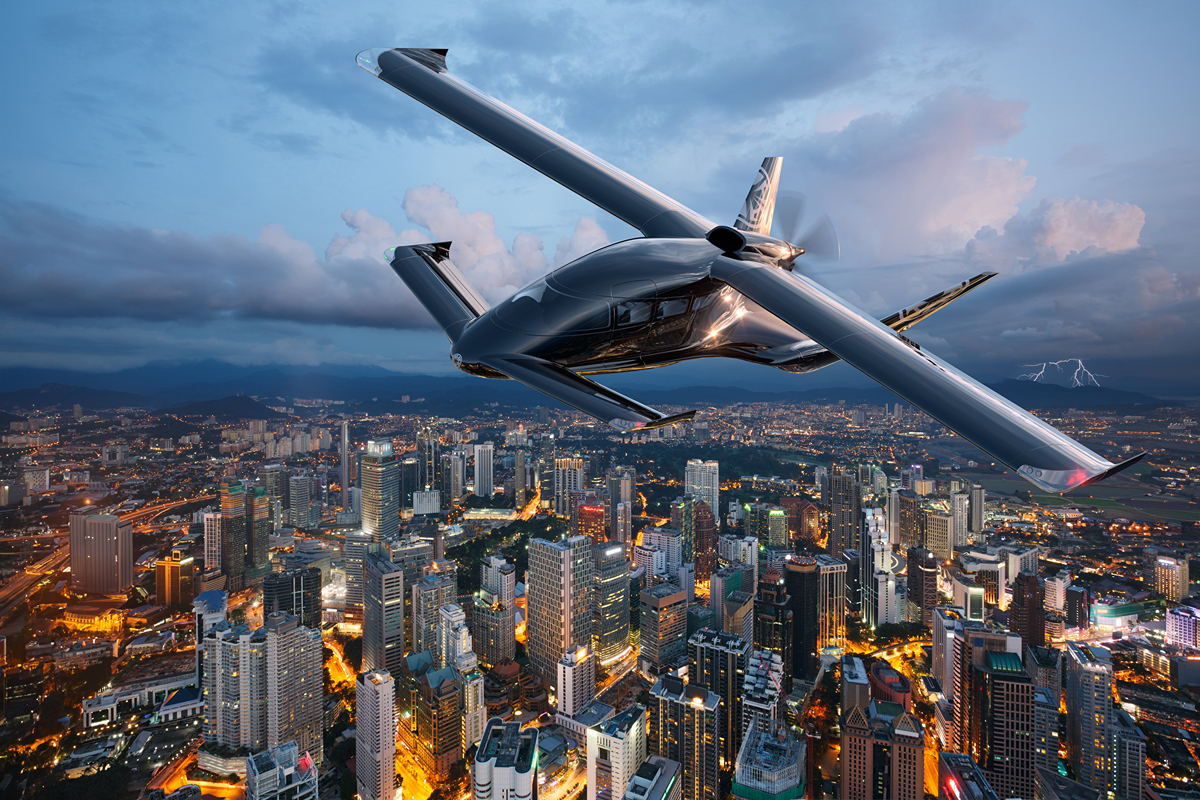
Specifications
Capable of carrying out stage lengths of up to 500 miles (800km) while cruising at a speed of up to 250 knots (450kph) the Cavorite X7 can carry payloads up to 680kg (1500lbs) if operating in vertical flight mode. This increases to 815kg (1,800lbs) if flying purely in conventional flight mode, using runways to take off and land. The maximum gross weight of the aircraft is stated as 2,500kg (5,500 lbs).
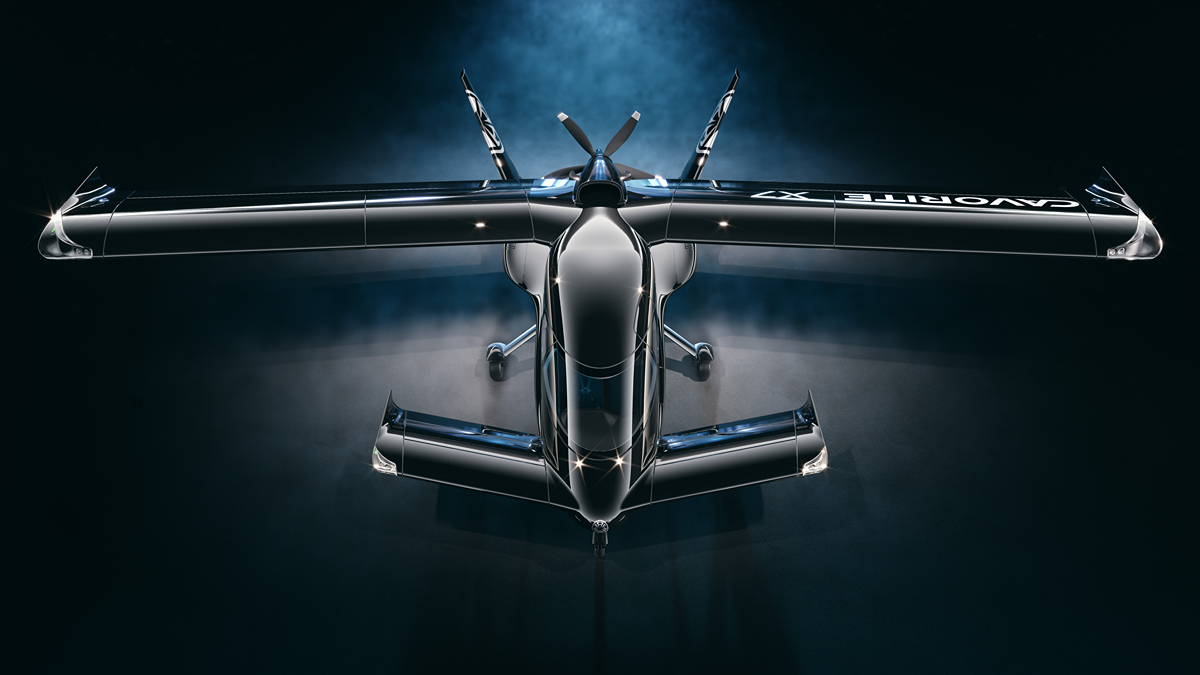
If carrying just a single pilot for ferry or positioning flights, the Cavorite X7’s maximum range increases to 900 miles (1,450km). In terms of dimensions, the Cavorite X7 measures 11.6 meters (38ft) in length, and 2.8 meters (9.2ft) in height. The aircraft will have a wingspan of 15 meters (50ft).
Performance
Horizon claims that the Cavorite X7 will be capable of using a variety of landing sites and airfields for operations, given its versatile configuration. For landing, it can use a conventional runway. Alternatively, the fans can be deployed to touchdown on a helipad, other paved or unpaved surfaces, or even on an area the size of a tennis court.
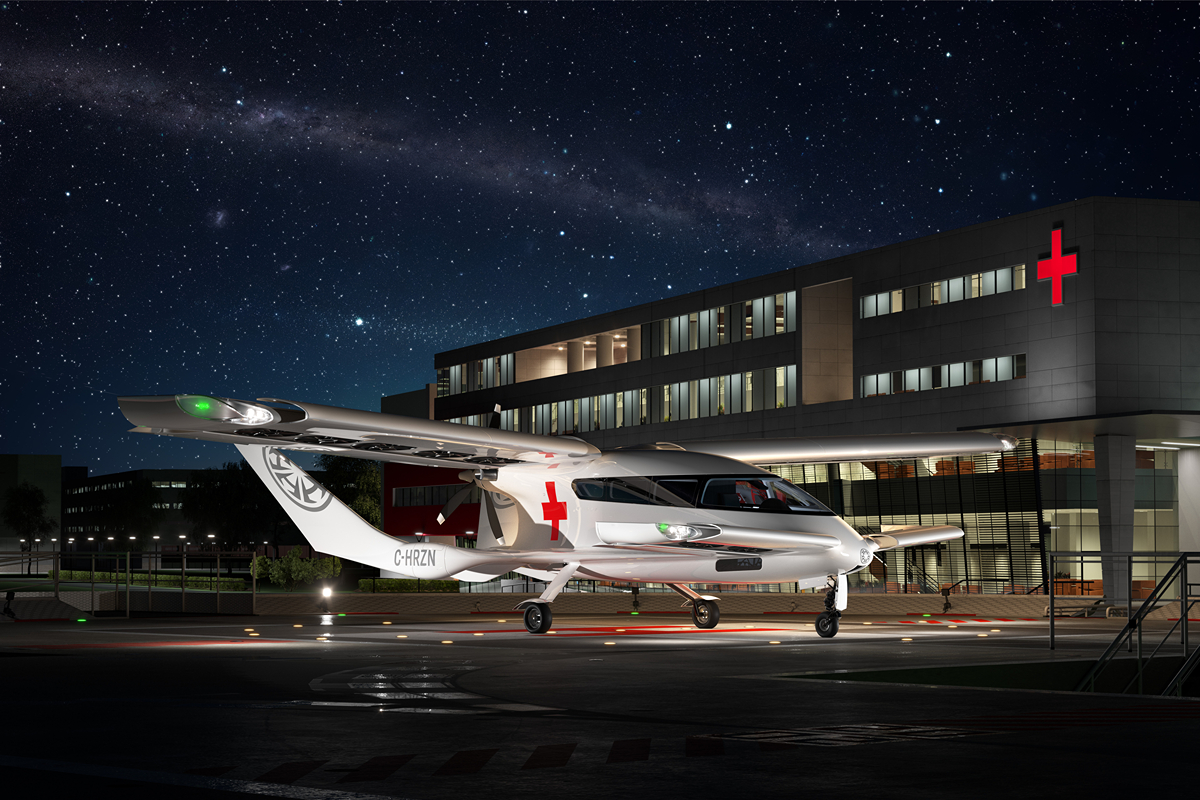
The aircraft can carry six passengers, plus a pilot, on missions up to 500 miles (800km) in length. This capacity sets the Cavorite X7 apart from its competitors such as the Archer Midnight, Joby Aviation S4, the Wisk Aerospace Generation 6, and the Vertical Aerospace VX4, which all carry fewer passengers. Only the Lilium Jet can compete in terms of having the capacity to carry seven people.
According to the company itself, this significant increase in passenger payload makes the economics of the Cavorite X7 favorable over its competitors. Its higher ability to carry a greater number of passengers reduces the cost per passenger, allowing for greater flexibility when setting fares or charging operator charter rates for the aircraft.
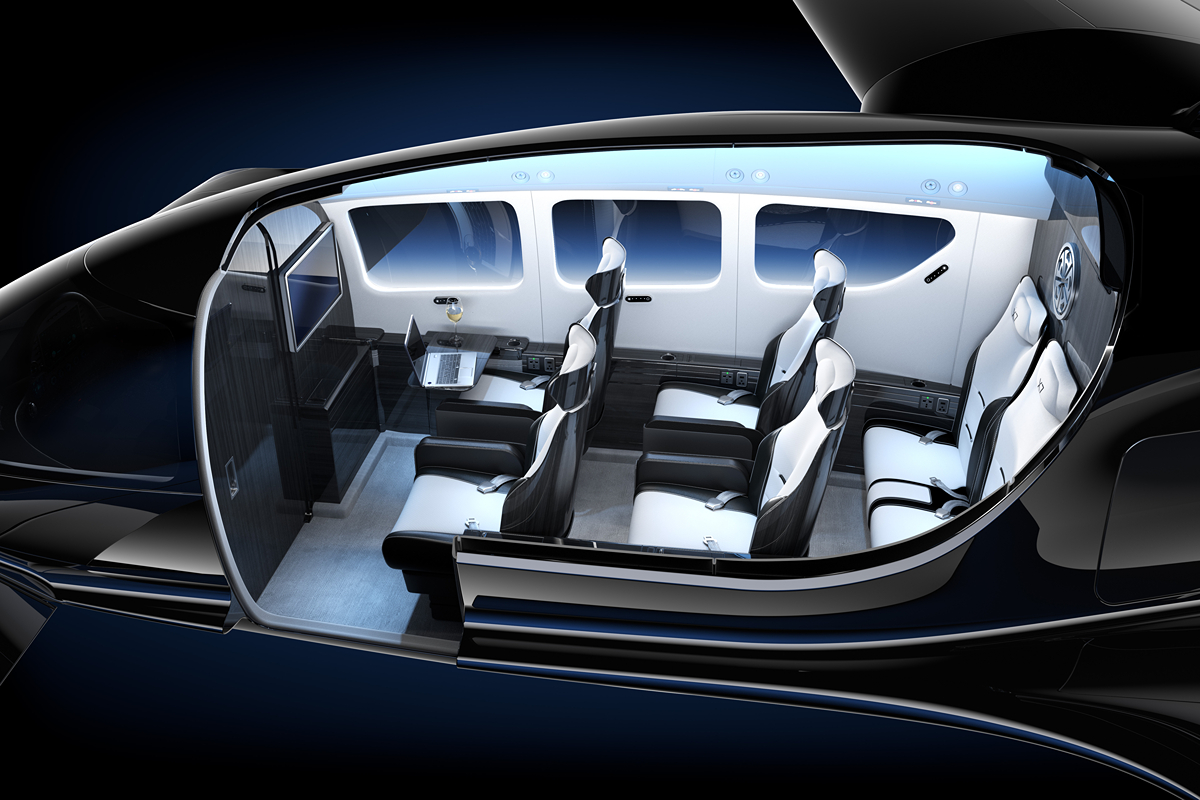
The company is keen to point out that the Cavorite X7 is being engineered for maximum safety in all weathers. Indeed, given the diverse climatic environments in which Horizon envisions its aircraft operating in the future, the company is using a design benchmark of the ability to fly into known icing conditions as a certification goal.
The company is aiming for the Cavorite X7 to be both VFR (visual flight rules) as well as IFR (instrument flight rules) certified, meaning that the aircraft will be capable of operating in inclement weather conditions, and its operation will not be impeded by weather that might otherwise keep it grounded.
Despite using all 14 lift fans in the hover phases of flight, a high level of redundancy has been built into the design so that even multiple failures can be tolerated to little effect. In the development stages, the Cavorite X7 prototype has managed to sustain a hover even with 30% of the fans disabled, the company says.
Horizon’s own projections indicate that the Cavorite X7 could offer as much as 30% lower direct operating costs than a helicopter conducting a similar regional transport mission. Additionally, it will be able to move people and cargo at almost twice the speed of a traditional helicopter, making it a viable competitor to such aircraft on similar missions.
Sustainability
Although the Cavorite X7 is initially being developed as a hybrid electric aircraft, the company is keen to point out that this will not always remain the case. The hybrid model was selected from the outset to meet the modern-day need for a longer-range light aircraft capable of vertical flight, while simultaneously cutting greenhouse emissions compared to traditional aircraft conducting similar missions, such as turbine-powered helicopters.
Many may argue that, given its conventional engine, the Cavorite X7 cannot be compared with the other fully electric eVTOL aircraft being developed. However, Horizon points out that most of its competitors’ aircraft carry more than 907kg (2,000 lbs) of lithium batteries onboard every flight and so cannot truly be regarded as totally emission-free.
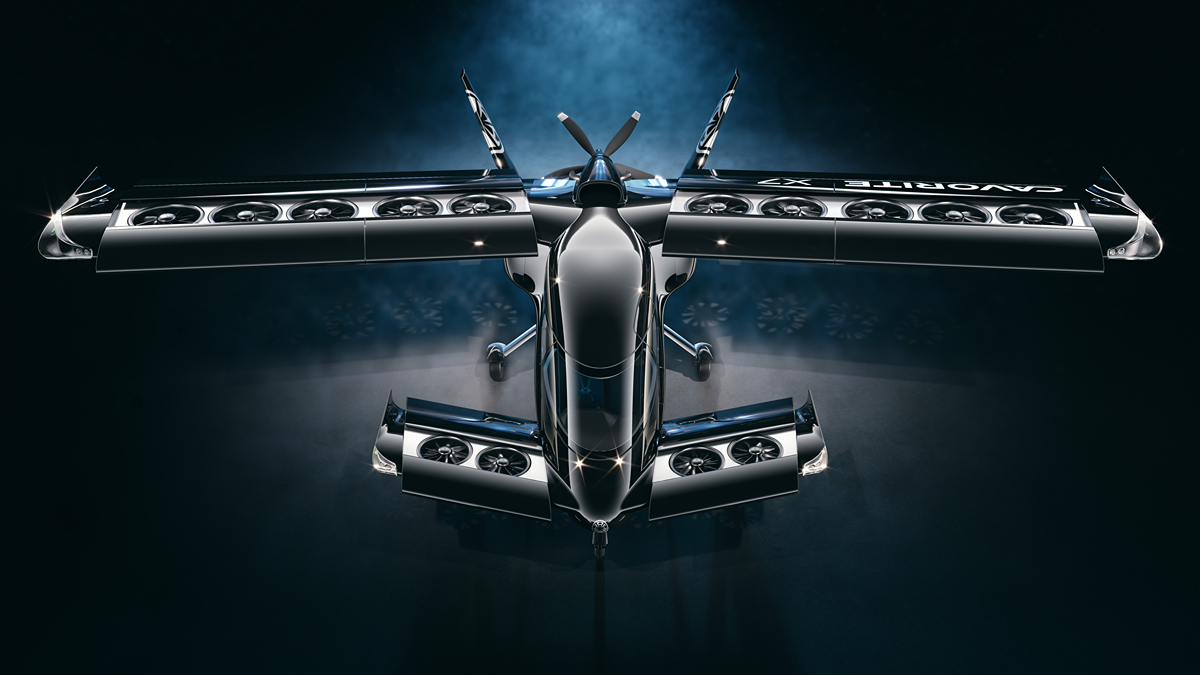
As modern lithium battery manufacturing consumes large amounts of energy, toxic chemicals, and immense amounts of water, the comparison is more of a level playing field than might first appear. According to Horizon, citing data from Earth.org, for every metric ton (2.200 lbs) of lithium mined, 15 metric tons (33,000 lbs) of carbon dioxide are released into the atmosphere.
Although a hybrid Cavorite X7 model is being developed in the first instance, battery technology continues to improve both in terms of energy and power density. Additionally, Horizon is continuing to monitor the developments in hydrogen-powered aircraft, and the innovative work being carried out by the likes of ZeroAvia and Cranfield Aerospace in this area. As soon as a viable power solution becomes available that can eradicate the need for the Cavorite X7 to rely on fossil fuel, then Horizon is committed to transferring that innovation into its aircraft.
Suitable missions
In a comment aimed at its future competitors in the eVTOL market, Horizon claims that its sights as an organization are set beyond “simply flying a couple of people to an airport or making commuting easier for a select wealthy few”.
Instead, the company is looking to make “a positive contribution to people’s lives by developing and manufacturing the Cavorite X7 to meet true regional transportation needs.” With its anticipated flexibility, speed, and unsurpassed range capability, Horizon is keen to highlight that the Cavorite X7 is ready to be used in several vital sectors and on both general and specialist missions.
For medical evacuation (medevac) operations, the company states that the Cavorite X7’s agility, capacity, and cabin configuration will enable the medevac of injured persons from accident sites or isolated areas to a hospital up to twice as quickly as a conventional helicopter. It also sees a role for the Cavorite X7 in the safe, swift transfer and delivery of organs and time-sensitive medication to medical centers, as well as carrying other crucial medical supplies.
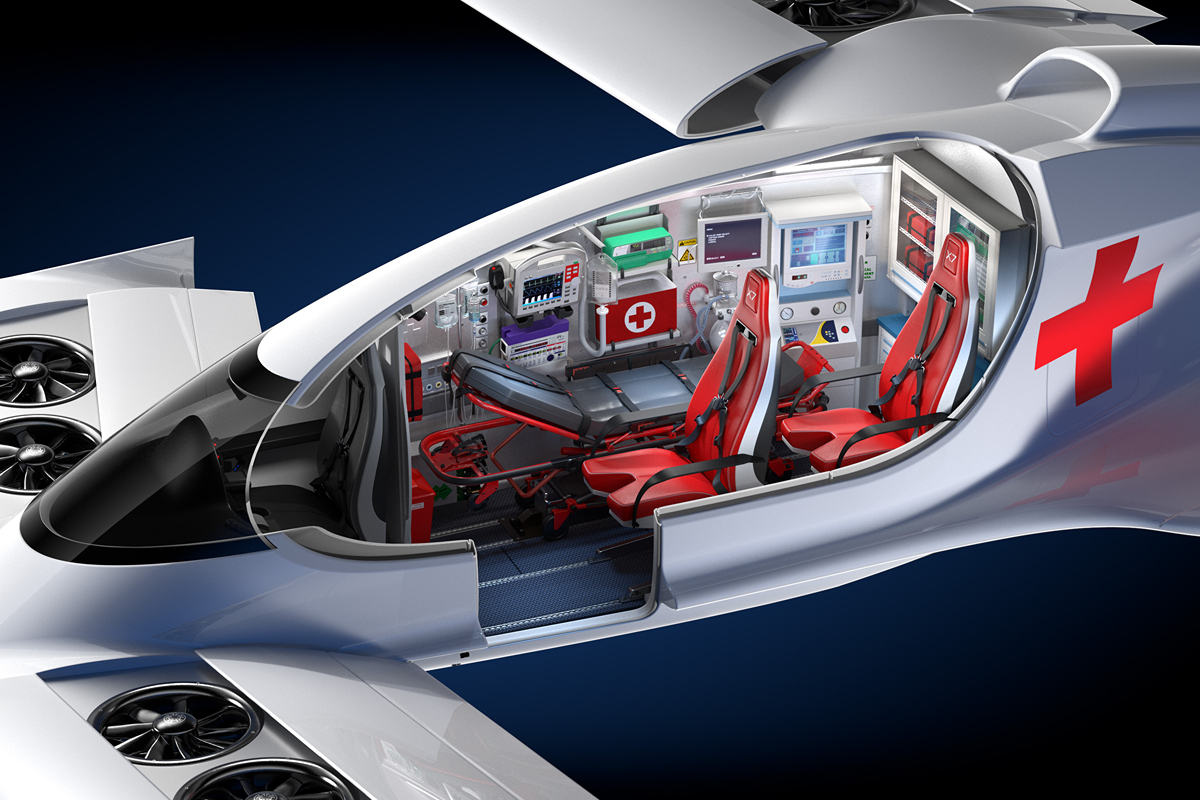
Regarding disaster response missions, as catastrophic weather is a growing threat to many regions around the globe, the company foresees the Cavorite X7 offering a “prompt, effective complement to state and federal operations through search and rescue missions and supply delivery to zones affected by tornadoes, hurricanes, landslides, storms, floods, or forest fires”.
The Cavorite X7 may also prove useful in terms of more general eVTOL duties. In addition to its suitability for inter-city business or personal travel, akin to the air taxi role being targeted by the other eVTOL developers, it has the capability to provide passenger shuttle and transportation services, plus the delivery of time-sensitive cargo and goods to underserved or remote regions.
Lastly, for performing specialist missions, the Cavorite X7 is being marketed by Horizon as offering “a cost-effective, nimble alternative for an array of applications”, including road traffic observation and control, emergency surveillance and crowd monitoring, investigative usage, missing person searches, and co-ordinating evacuation efforts in advance of catastrophic weather conditions.
Timeline to certification
As the Cavorite X7 will mostly fly as a conventional fixed-wing aircraft, Horizon believes that it will be safer, and hence easier, to certify than other eVTOL aircraft currently under development or undergoing certification testing. Additionally, the Cavorite X7 will be powered by a hybrid electric system that will recharge the battery array in-flight as well as post-flight, while also providing significant system redundancy, and these aspects should also expedite the certification program.
The Cavorite X7 journey started in January 2021 when Horizon revealed its Cavorite X5 preliminary design, followed by the successful first flight of a downsized prototype in March 2021.
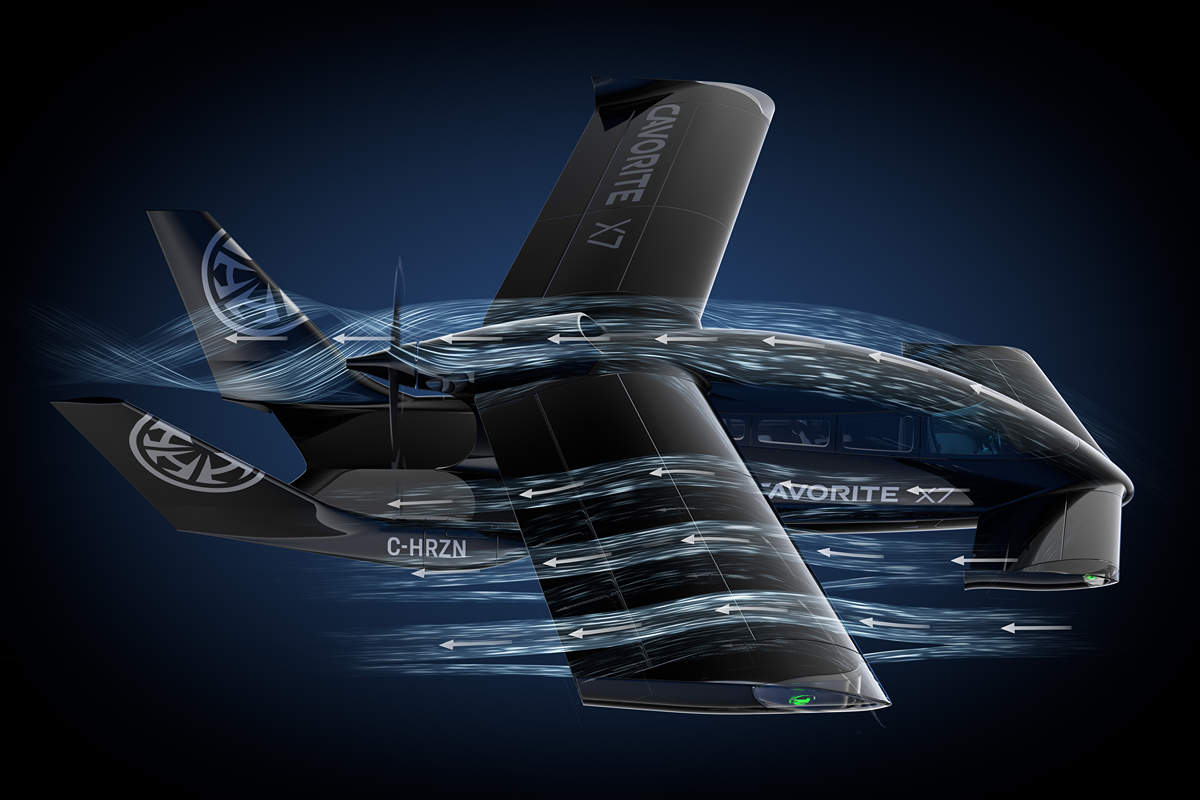
In January 2022, Horizon was awarded a US Department of Defense Phase 1 High-Speed Vertical Take-off and Landing contract, while August 2022 saw the first flight of a larger scale (50%) prototype. In December of that same year, this was followed by the first tethered outdoor flight test of the 50%-scale prototype.
In March 2023, the 50%-scale prototype underwent wind tunnel transition flight testing of the 50%-scale prototype. Then, in August 2023, certifying authority Transport Canada gave its approval for remotely piloted outdoor transition flight tests to commence.
We then fast forward to September 2024, when Horizon announced that it is embarking on the next milestone phase of developing the Cavorite X7. The aircraft’s flight test program has seen the prototype achieve hundreds of successful flight tests with the program heading towards full transition speed tests, which it’s hoped will be completed by the end of 2024.
According to Horizon, the real-world test results “are rapidly improving the design and production of the full-scale aircraft and its sub-systems”. Meanwhile, the company is continuing to develop key technologies that underpin the Cavorite X7, including the full-scale propulsion units that are key to the HOVR Wing technology.
Brandon Robinson, CEO of Horizon Aircraft said in September 2024: “I am extremely proud of the pace of our full-scale aircraft systems development program, the world-class team we’re building, and the game-changing technology that we’re bringing to Advanced Air Mobility.”
“Our unique, customer-first approach prioritizes building a tough eVTOL aircraft that can operate in bad weather, icing conditions, and other challenging operational environments. This strategy is gaining strong traction with operators, driving substantial demand,” Robinson added.
Summary
In what is becoming a crowded landscape in advanced air mobility, many developers are focussing on the urban-centric market. However, Horizon’s concept of introducing a hybrid and versatile eVTOL aircraft may just set it apart from the competition, in what will undoubtedly become a cut-throat competition to secure sales to customers.
While Horizon’s Cavorite X7 may not be fully electric at this stage, its range and payload capabilities will still be an attractive proposition to operators in markets where other eVTOL (and conventional helicopters) cannot compete. In such markets, it is likely to be on longer-range specialist missions that the Cavorite X7 will carve a niche for itself. However, with any such project driven by a combination of innovation, ambition, and vision, only time will tell whether this proves to be the case.

